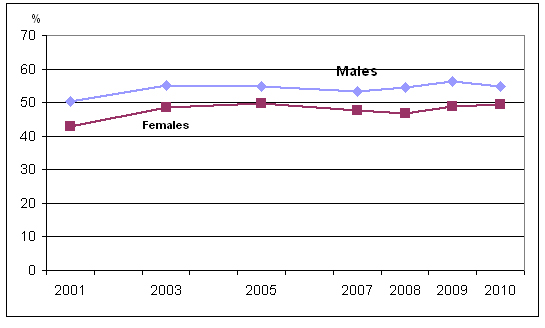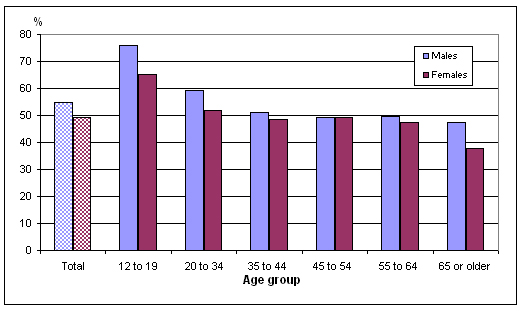Physical activity during leisure time, 2010
Archived Content
Information identified as archived is provided for reference, research or recordkeeping purposes. It is not subject to the Government of Canada Web Standards and has not been altered or updated since it was archived. Please "contact us" to request a format other than those available.

The health benefits of physical activity include a reduced risk of cardiovascular disease, some types of cancer, osteoporosis, diabetes, obesity, high blood pressure, depression, stress and anxiety.1
In 2010, 52.1% of Canadians were at least 'moderately active' during their leisure time - energy expended at work, in transportation or doing housework is excluded. 'Moderately active' would be equivalent to walking at least 30 minutes a day or taking an hour-long exercise class at least three times a week.
The most popular leisure-time activity was walking: almost 70% reported walking during leisure time in the past three months. Gardening, home exercise, swimming, bicycling and jogging were also popular.
From 2001 to 2010, males were more likely than females to be at least moderately active. In 2010, 54.9% of males reported that they were at least moderately active during leisure time, down from 56.4% in 2009. The proportion of females who were at least moderately active was 49.4%, about the same as in 2009 (Chart 1).
Chart 1
Percentage physically active or moderately active in leisure time, by sex, household population aged 12 or older, Canada, 2001 to 2010

Source: Canadian Community Health Survey, 2001, 2003, 2005, 2007, 2008, 2009, 2010.
Canadians aged 12 to 19 had the highest rate of being at least moderately active (75.8% for males and 65.4% for females in this age group).
After age 19, the percentage of females who were at least moderately active stabilized at about 50%; at age 65 or older, the figure dropped to 37.7%. Among males, the percentage that was at least moderately active leveled off around 50% after age 34, and remained there through the senior years (Chart 2).
Chart 2
Percentage at least moderately active in leisure time, by age group and sex,household population aged 12 or older, Canada, 2010

Source: Canadian Community Health Survey, 2010.
Only in Alberta (55.9%), British Columbia (58.3%) and Yukon (61.7%) were the proportions of residents who were at least moderately active higher than the national average. Residents of Newfoundland and Labrador, Quebec and Ontario reported levels of moderate physical activity that were lower than the national average.
End note
- Gilmour, Heather. 2007. "Physically active Canadians." Health Reports. Vol. 18, no. 3. August. Statistics Canada Catalogue no. 82-003. page 45. /pub/82-003-x/2006008/article/phys/10307-eng.pdf (accessed May 10, 2010).
References
Gilmour, Heather. 2007. "Physically active Canadians." Health Reports. Vol. 18, no. 3. August. Statistics Canada Catalogue no. 82-003. pages 45–65. /pub/82-003-x/2006008/article/phys/10307-eng.pdf (accessed May 10, 2010).
Shields, Margot and Mark S. Tremblay. 2008. "Screen time among Canadian adults: A profile." Health Reports. Vol. 19, no. 2. June. Statistics Canada Catalogue no. 82-003. /bsolc/olc-cel/olc-cel?lang=eng&catno=82-003-X200800210600 (accessed May 10, 2010).
Shields, Margot and Mark S. Tremblay. 2008. "Sedentary behaviour and obesity among Canadian adults." Health Reports. Vol. 19, no. 2. June. Statistics Canada Catalogue no. 82-003. /bsolc/olc-cel/olc-cel?lang=eng&catno=82-003-X200800210599 (accessed May 10, 2010).
Data
Additional data from the Canadian Community Health Survey are available from CANSIM table 105–0501 and summary tables Physical activity during leisure time, by age group and sex and Physical activity during leisure time, by sex, provinces and territories.
- Date modified:
